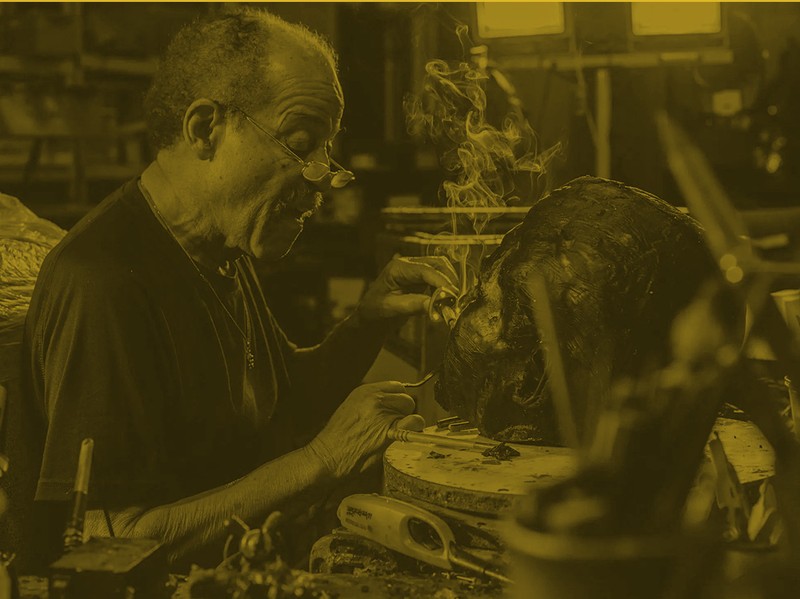Edward Dwight Jr.
Introduction
Text-to-speech Audio
Edward Dwight was born and raised in Rattlebone Hollow, and after becoming the first African American male to graduate from Bishop Ward, went on to pursue an engineering degree from Kansas City Junior College where he also enlisted in the Air Force. Dwight was one of the first African Americans to enlist in the Air Force’s astronaut training program. His successful career led the Kennedy administration to select him as a candidate to become one of NASA’s newest astronauts–a campaign which controversially ended with Edward not being selected. Soon after, Dwight returned to his artistic roots and began designing memorials and sculptures found all over the world, including several locations along the Underground Railroad.
Images




Backstory and Context
Text-to-speech Audio
Edward Dwight Jr. was born in 1933 in Kansas City, Kansas to Monarchs baseball star Ed Dwight Sr. and his wife Georgia. Dwight grew up in Rattlebone Hollow, on the end of N. Tremont St. and this is also where he nurtured his love of art and appreciation for flight. At an early age, Ed was artistically gifted and extremely intelligent. After his mother petitioned the Vatican to require Bishop Ward to integrate to allow her son to attend a Catholic School, he became the first African American to attend and then graduate in 1951. During his teenage years, he often would spend hours in the library devouring air force flight manuals. He went to college to pursue a degree in aeronautical engineering, both to appease his father’s demand of him becoming an engineer while also nurturing his dream of one day becoming a pilot.
Dwight joined the AirForce in 1953, being one of 33 men to pass the test. While serving in the AirForce, Dwight quickly worked his way up the ranks while continuing his education at UC Berkeley. Throughout his AirForce career, Dwight was able to fly a variety of planes, even those that were highly advanced for the time. While out testing planes and flying for the Air Force, Ed accumulated over 9,000 hours of flight. It was his renowned experience in flight that aided in his selection to be a candidate for NASA’s astronaut program. In the 1960’s Dwight found fame after garnering national attention in his pursuit to become the first African American astronaut.
Dwight was the only African American who received entry to the NASA test program and had received a personal letter of recommendation from President Kennedy. While this was the opportunity of a lifetime and Ed garnered a great deal of fans who would even pen him fan mail, Dwight was subjected to racial tension and bullying as he was one of few African Americans present at the facility and was made an example while experiencing the four-year program. Even though he had received a personal recommendation from the White House, the officer in charge did not appreciate this overstep and made it a mission to force Ed out. Despite making it through to graduate the program, reaching eligibility for space, Dwight lost out to officially become an astronaut. While Dwight made waves for African Americans looking to pursue flight and aeronautical careers, it wasn’t until 1983 that an African American would go to space.
In 1966, Dwight left his military career, and went on to pursue his second love–art. After moving to Denver to start his own studio, characteristically in an airplane hanger, Dwight then traveled across the country to create sculptures in honor of African Americans and their hardships and triumphs. Many of his works are featured along the route of the former Underground Railroad. Dwight founded the AAAC, or African American Artists Collective. In 1975, Dwight's first major piece to garner national attention was commissioned by Denver to honor African American history. It eventually was on exhibit in the Jefferson National Memorial. This success then led to another famed piece, honoring the history of jazz in the African American Community. More recently in 2009, Dwight was commissioned by the Obama Administration to create a sculpture of his inauguration and can still be seen on exhibit throughout the US. In 2009, Dwight also published an autobiography, ‘Soaring on the Wings of a Dream’ to account for his life accomplishments and his trying times working towards becoming an astronaut.
Sources
Accessed April 19th, 2022. https://www.nytimes.com/2019/07/16/us/ed-dwight-was-set-to-be-the-first-Black-astronaut-heres-why-that-never-happened.html.
Chen, Jen. KCK Native On Being The First African-American To Train For NASA, KCUR. January 19th, 2017. Accessed April 19th, 2022. https://www.kcur.org/show/central-standard/2017-01-19/kck-native-on-being-the-first-african-american-to-train-for-nasa.
Craig, Maureen. The History Behind a Great Institution.., Bishop Ward High School . Accessed April 19th 2022. https://www.wardhigh.org/page/this-history-of-bishop-ward.
Jackson, Shareef. Ed Dwight Was Going to Be the First African American in Space. Until He Wasn’t, Smithsonian Magazine. February 18th, 2020. Accessed April 19th, 2022. https://www.smithsonianmag.com/history/ed-dwight-first-african-american-space-until-wasnt-180974215/.
